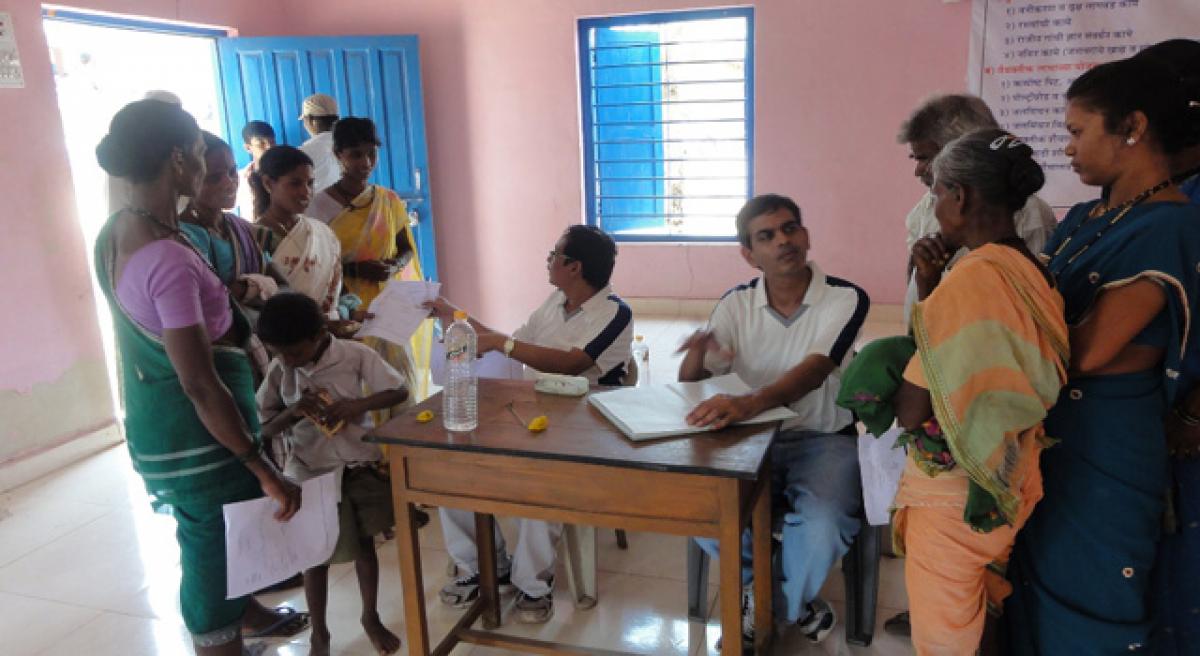Live
- Must-Watch OTT Originals in 2024: The Year’s Best Shows and Movies
- 40 Indian startups secure over $787 mn in a week
- India now formidable force on chess board
- Raghavendra Mutt pontiff visits Tirumala
- Whistleblower of OpenAI found dead in US apartment
- Trump’s US-first policy & India’s strategic latitude
- Chandrababu pays tribute to Potti Sriramulu and Sardar Vallabhbhai Patel
- India may miss TB elimination target
- Revolutionizing Women’s Health: The Era of AI
- Govt bill explains plan for ONOE
Just In

Nine of India’s poorest states -- home to 581 million or 48 per cent of the population -- account for 70 per cent of the country’s infant deaths, 75 per cent of under-five deaths and 62 per cent of maternal deaths, but do not spend even the money they have set aside for healthcare, according to an IndiaSpend analysis of 2017 Reserve Bank of India data on state budgets.
Nine of India’s poorest states home to 581 million or 48 per cent of the population account for 70 per cent of the country’s infant deaths, 75 per cent of under-five deaths and 62 per cent of maternal deaths, but do not spend even the money they have set aside for healthcare, according to an IndiaSpend analysis of 2017 Reserve Bank of India data on state budgets.
The data also reveal:
The maternal mortality ratio -- deaths of mothers per 100,000 births -- in these states is 32 per cent higher (244) than the national average (167). 38 per cent and 40 per cent children in these states are underweight (low weight-for-age) and stunted (low height-for-age), respectively, higher than the national average of 36 per cent and 38 per cent, respectively, according to 2015-16 national health data, the latest available.
Uttar Pradesh, Bihar, Madhya Pradesh and Rajasthan -- with 372 million people, more than the combined populations of US, Australia, Sweden and Greece --together contribute to about 58 per cent of all child deaths in India. The nine poorest large states -- in official jargon called “high-focus”, a term that implies they need special attention -- spent an average of 4.7 per cent of their social-sector expenditure on public healthcare and family welfare annually, marginally less than the national average of 4.8 per cent. Social-sector expenditure includes water supply and sanitation, housing and urban development.
India’s average spending on health, as a proportion of GDP, is already the lowest among BRICS nations. The “high-focus” states are Bihar, Chhattisgarh, Jharkhand, Madhya Pradesh, Odisha, Rajasthan, Uttarakhand, Uttar Pradesh and Assam. “In 2005, it was observed by (the) Government of India that some states were performing poorly in various indicators,” Avani Kapur, Senior Researcher, Accountability Initiative, an advocacy, told IndiaSpend. “So, these states were clubbed together as high-focus states and additional resources were given to improve those indicators.”
Of the nine poorest states, Rajasthan spent the highest (5.6 per cent) and Bihar the lowest (3.8 per cent) proportion of aggregate expenditure on public healthcare and family welfare, according to the RBI data on 2014-15 actual spending, lower than the budgeted 4.1 per cent for Bihar and 6.6 per cent for Rajasthan.
Seven of the nine “high-focus” states report such underspending. “High focus states allocate large amounts to social sector to improve their indicators but in reality they spend only a small amount, compared to what is allotted,” Kapur said. “Hence, it is necessary to consider actual accounts in order to know the proper outcomes.”
So, while some “high-focus” states spent less money than set aside by their budgets, other states outspent -- by proportion as ratio to aggregate expenditure -- other larger states on healthcare and family welfare, but that had no relation to their healthcare indicators. For instance, Rajasthan (68.6 million people) reported an MMR of 244 deaths per 100,000 births in 2011-13, the second lowest in India and worse off than Bangladesh and Nepal, both poorer countries, by per capita income. In contrast, Andhra Pradesh (84.6 million people), another big state, spent 4.1 per cent of total expenditure on public healthcare and family welfare but reported an MMR of 92, according to government data.
Since 2008, Rajasthan increased its spending by 0.8 per cent and its MMR decreased 23 per cent while Andhra Pradesh’s spending increased by 0.5 per cent and MMR decreased 31 per cent. Assam, which spends 4.2 per cent of its total expenditure on health and has 31.2 million people, has an MMR of 300 deaths per 100,000 births -- comparable to Rwanda and Sudan -- while Kerala, which spends 5.3 per cent on 33.4 million, reported an MMR of 61, comparable to Sri Lanka and Poland. (By arrangement with IndiaSpend.org)
By Ojaswi Rao

© 2024 Hyderabad Media House Limited/The Hans India. All rights reserved. Powered by hocalwire.com







